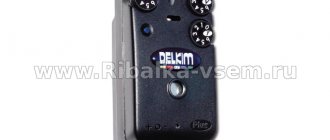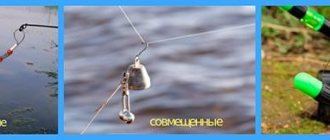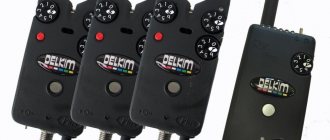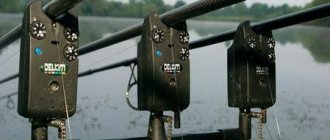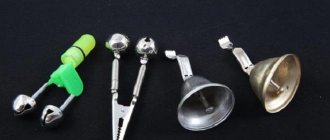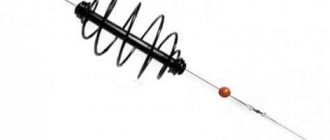Bite alarm for carp fishing
A bite alarm is an important element in modern fishing gear, the task of which is to indicate when a fish is biting.
These devices replaced bells and various rattles that had already become ancient among fishermen. You can learn how to make a bite alarm with your own hands from our article.
Signalers are of the following types:
- Mechanical.
- Electronic.
Visual bite alarms should be selected based on the fishing location and the gear that the fisherman will use.
Tackle with a sliding weight is designed for fishing in coastal areas. For this type of gear, it is better to use electronic identifiers with high sensitivity and mechanical alarms with as little weight as possible to tighten the fishing line.
Many fishermen do not really like to use such “newfangled” alarms, which are quite expensive, and there is no mistake in this, since the bite alarm is not the main equipment, such as, for example, a fishing rod or bait, but only additional.
Therefore, whether to use it or not, everyone must decide for themselves, besides, now you can make such bite alarms with your own hands, which will be much cheaper, and the quality will not be inferior even to the average identifier.
Types of bite alarms
Not long ago, the most popular and widespread bite alarm was considered to be a regular bell. But the variety of fishing methods invariably leads to modifications and improvements in the gear used in this process. Today there are many different bite alarms: from simple floats to complex electronic models.
Mechanical

These include fishing swingers, springers and hangers (bats). Fishing swingers have an all-metal leg, bracket, head with line clamp, and a movable back that attaches to the alarm and stand. Some fishing swingers have a backlight function. In springers, the indicator is mounted on the crossbar and is a small plastic cylinder with a graphite rod. Bats are the lightest of mechanical bite alarms. With them, fishing can be carried out even with a loose line. Instead of a metal leg, bats have a metal chain or an even lighter part.
Visual

The most basic to use, but no less effective signaling devices (tubes made of aluminum foil, fireflies, nods, floats). The advantage of such alarms is the ability to accurately determine the bite and hook the fish at the right time. The disadvantages include the fact that inexperienced novice fishermen do not always notice the movement of such a signaling device in time and may miss a possible catch.
Electronic

The advantages of such alarms include reliability and a high level of sensitivity. In addition, they can operate for a long time on one energy source. Bite alarms of this type transmit the necessary signal to the angler using light, sound or radio waves to a pager. When choosing electronic bite alarms, a number of mandatory requirements must be met:
- Possibility of easy adjustment in conditions of poor visibility;
- Convenient packaging for moving all parts;
- Low energy consumption;
- The presence of a waterproof case.
The advantages of alarms of this type include high sensitivity and maximum accuracy in determining the bite level, immunity to weather conditions, and a lower number of false alarms compared to other types of alarms. The disadvantages include the rather high cost and the absence of a charge indicator in some models.
Visual bite alarms
Visual (mechanical) bite identifiers are a type of bite indicator. They come in the following varieties:
- Swingers.
- Hangers (or bahts).
- "Monkey".
- Springers.
Swingers
The swinger is a very popular mechanical alarm for carp fishing. It looks like a small plastic head with a special clamp for installing fishing line. On the other side of the clamp there is a lever on which the weight is attached. The second side of the lever is fitted to a hinge with a bracket that is attached to the rod stand.
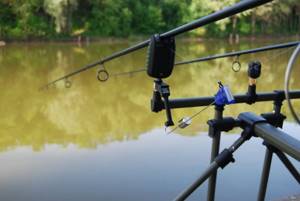
The swinger line for the fishing process is inserted into the clamp, and the degree of tension is adjusted by moving the weight along the lever - the closer it is to the plastic head, the greater the tension of the line. The optimal line tension should not be too tight, but there is also no need to allow sagging.
A swinger weight typically weighs no more than 100g, which is enough to set the appropriate line tension even in a body of water with strong currents. If the fisherman cannot balance his tackle, then in such cases it is permissible to use additional weight.
Hangers
The hangers are an oval made of plastic, at the top of which there is a small clamp for the fishing line, and at the bottom, collapsible weights are attached to allow the tension of the fishing line to be adjusted. The signaling device itself adapts to the front crossbar using a small chain. Hangers are most often used when fishing in various lakes and ponds.
When fishing in a body of water with a strong current or at a fairly long distance, this alarm usually lacks the required weight of the weights that are included in the kit for sufficient line tension. Therefore, many companies produce additional weights with greater weight for fishing in such an environment.
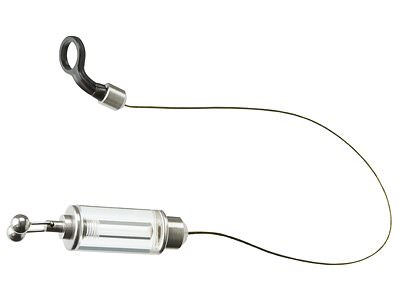
The main advantage of hangers, or “bats” as they are also called, is their very good sensitivity compared to all other visual identifiers. In addition, it also has excellent mobility, so it will catch a very careful, barely perceptible bite, which is a strong argument in its favor.
The disadvantage of the hanger is its instability to gusts of wind. Therefore, for such conditions, the most suitable model would be one with a steel bracket. Such devices usually contain an LED already mounted, and they are quite practical for transport and will quickly be installed in place in the stand.
"Climbing Monkey"
The climbing monkey is made from an oblong steel rod that goes into the ground under the rod between the reel and the electronic ID. A plastic cylinder moves along the rod, under which the fishing line fits, and its tension is adjusted using special weights that are attached to the cylinder.
When hooking, the weight comes off the rod and weakens the line. The main advantage of this device is its good durability, which does not allow the signal to trigger falsely when biting. The main disadvantage is low sensitivity.
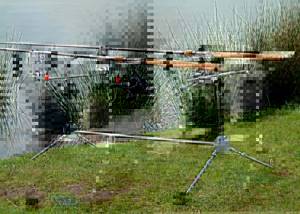
Springers
Springers are made of plastic and have a cylinder shape that is attached to a fairly flexible rod. This rod adapts to the crossbar thanks to a special adapter. The line tension can be adjusted due to the good flexibility of the graphite rod using a special additional lever located in the adapter.
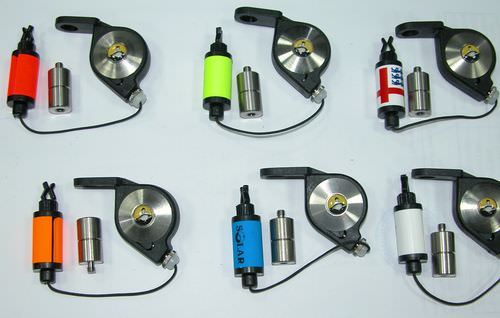
Springers are quite sensitive. They are sturdy and easy to transport because they don't take up much space. Their only drawback is poor line tension.
Advantages of visual alarms:
- Provide greater sensitivity of the gear.
- They provide the opportunity for trouble-free and quick adjustment of line tension.
- Very quickly and accurately regulate the fish bite, without giving false signals due to wind, waves, etc.
- Large selection of models.
Disadvantages of visual alarms: difficult installation of these devices.
Sound alarms

A universal model that can be used both day and night. Very often, sound devices can be found in combination with luminous bite indicators. This group may include both mechanical and electronic devices. The first group includes bells and bells, and the second category includes devices that use batteries/sound buzzers to sound.
An undeniable advantage of sound devices is the ability to send a signal over long distances. The only disadvantage is reduced efficiency when fishing in strong wind conditions. That is, there are false alarms of the controller.
The most primitive version of a sound bite alarm is a product made from a pair of hollow tubes. The main thing here is that when two elements touch, a characteristic noise is created. The tubes are tied with a thread at the ends and thrown over a cord. At the moment the tension of the working line changes, the tubes touch each other and notify the angler that a fish has been hooked.
Bell

This is a classic version of an audible alarm. It is presented in the form of an ordinary miniature bell made of copper/brass. The bell is installed on the cord between the first pass ring and the coil through the use of special clamps. You can also use fragments of rubber with slots here.
To simplify the task when disconnecting the bell while reeling in the cord and fishing the prey ashore, you can additionally secure it with a piece of fishing line to the stand. You can also attach the bell to a peg driven into the ground.
Expert opinion
Anton Timoshin
Feeder fishing expert
Ask a Question
I believe that in classic feeder fishing, bite alarms are not needed, except for the quivertip itself. Even when fishing at night, you can get by with a good flashlight. I would use bite alarms when catching burbot and catfish on donkeys.
Expert answers to questions
What if you are fishing on two feeders at the same time?
Similarly, we determine the bite by the quivertype of the feeder
If a beginner doubts the correctness of bite detection, should he start with a bell, for example?
Absolutely not. It is not right. It’s better to learn how to fish correctly with a feeder right away.
Bells
Bells are closed-type signaling devices; they consist of 2–3 spherical hollow bodies. They have slots for sound, which is produced as a result of movement inside the balls. In most cases, such bite indicators are mounted on a rod stand. It is unwise to attach them to the feeder without any support. It's not practical. If you fix the bells to the top of the rod, it will be overloaded, which is not desirable.
To ensure free movement of the bite indicator, the bells should be mounted on a stand with a small gap. This will ensure the clarity of the transmission of their vibrations.
Basic requirements for visual signaling devices
The main characteristics that high-quality bite alarms must meet:
- They should be visible against different nature backgrounds (grass, water, etc.).
- Be able to mount it on a stand as quickly and without problems as possible.
- Contain a built-in LED that will glow when a fish bites.
- Do not stagger in gusts of wind, be persistent.
- Have the ability to independently regulate the degree of line tension.
- Instantly push the line away when a fish bites.
It is better to purchase visual alarms with the following characteristics:
- Availability of additional lighting.
- Allows the swing arm to move in the hinge without unnecessary friction.
- Function for quick adjustment of line tension.
- The presence of a removable mounting platform, which can quickly attach and detach the indicator, and will also connect the necessary connectors to the electronic indicator.
- The presence of slow adjustment of the clamping force of the clip.
- The clip must be made of high-quality material and from a trusted manufacturer (beware of cheap, low-quality fakes).
How to make your own bite alarm
At home, you can make a side bite alarm, which can be successfully used even in strong winds. To make such a signaling device you will need:
- elastic steel wire 20 cm long and 0.8 - 1 mm in diameter;
- metal rod and fastener clamp for PVC pipes (the diameter of the rod is selected in accordance with the hole in the clamp);
- sewing thread;
- instant setting glue;
- bright metal paint or varnish.
The end of the rod must be sanded so that it fits tightly into the side hole in the clamp. Next, bend the wire in an arc. Bend one of its ends (0.5 cm) at an angle of 90 degrees relative to the main part of the wire and insert it into the hole on the metal rod.
Then you should lubricate the rod and the bent end of the wire with glue, after which you should wind the sewing thread around the glue (quite tightly). In this case, you need to ensure that the wire carefully adheres to the metal rod. Next, you need to apply the next layer of glue and give the resulting bite alarm the required color using varnish or paint.
In addition to the side signaling device, you can also make a nod yourself. To do this, you will need rolled aluminum foil. The foil tube is put on the main line in the place between the first ring and the reel. The line should sag a little in this place. The principle of operation of this alarm is that when a bite begins, the fishing line is tensioned in this place and the foil produces a rustling sound, thereby giving the fisherman the necessary signal. But in strong winds, such alarms are not used due to the lightness of the material used.
In some cases, fishermen use various improvised objects as bite alarms: rollers, nuts, etc. This is acceptable, but only as a temporary measure, since this method negatively affects the condition of the gear.
Manufacturers, best models and estimated prices for visual alarms
The best manufacturers and their models of visual alarms:
Fox companies – Euro MK2 Swinger, price from 20,000 rubles.
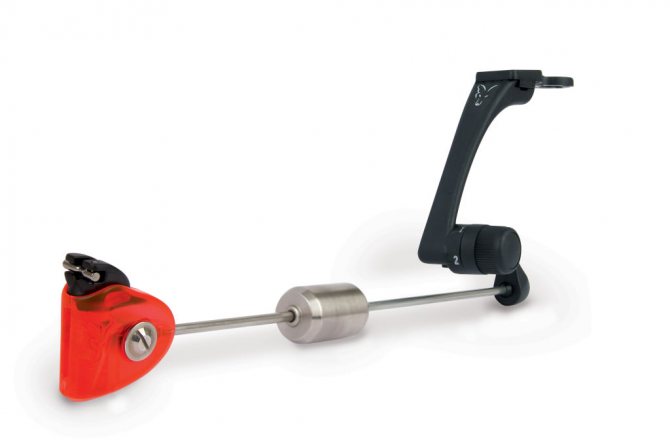
PixelGroup, price from 25,000 rubles.
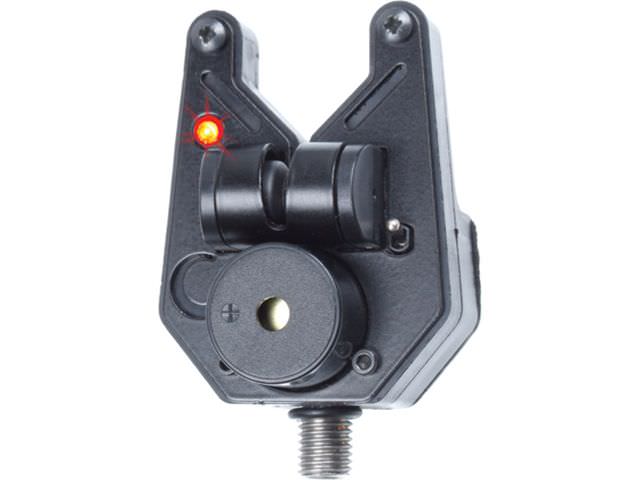
Hanger Nash Sirene Slix Indicator (set), price from 43,000 rubles.
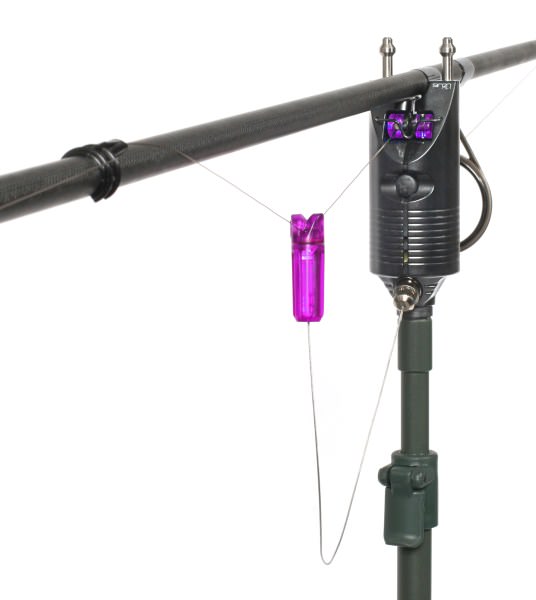
Hanger Century Neville Stainless Ultimate Hanger, price from 50,000 rubles.
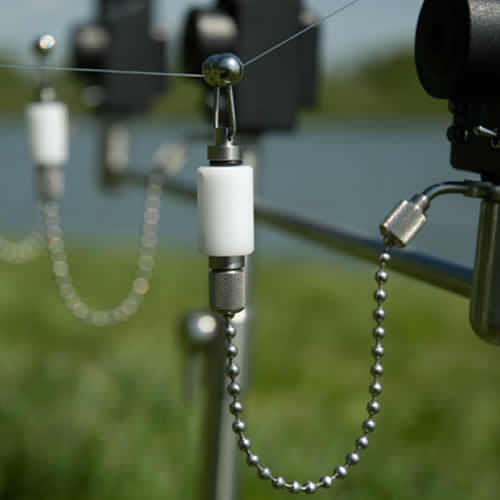
Rating of the best bite alarms
| Nomination | place | Name of product | price |
| The best mechanical bite alarms | 1 | Crane Megatex | 980 ₽ |
| 2 | Prologic K3 Hang Indicator Set 3 Rod | 5 300 ₽ | |
| The best electronic bite alarms | 1 | Prologic K3 Bite Alarm Set 4+1 | 22 800 ₽ |
| 2 | 4+1 JZH-RF-1118 | 7 800 ₽ | |
| 3 | SWD JHA-521 (4+1) | 6 350 ₽ | |
| 4 | German Barracuda TS 4+1 | 4 000 ₽ | |
| 5 | Flajzar Neon TX3 Set 4+1 | 30 000 ₽ |
Sound (electronic) bite alarms
The principle of operation of electronic devices is that it “tells” the fisherman in time that the fish are biting, even if he does not see the fishing rods. It will also help you instantly react to a barely perceptible bite of carp, reporting this with a special sound signal.
Such alarms differ from each other in the presence of various built-in functions and adjustments. For example, these could be functions for adjusting sound, light, tone, adjusting sensitivity, etc. The number of such functions largely depends on the price of a particular indicator model.
DIY bite alarm
The most common homemade donkey gatehouses are:
- pendulum type;
- nod type.
A homemade universal signaling device for donkey is mounted on a fishing line and attached to the rod rings. When a fish bites, the tackle, which is in a tense state, changes its position in the water, and the fishing line moves, transmitting vibrations to the guard.
The advantage of such a signaling device is that it is attached to the rod and remains hanging on its ring when hooking. However, the fisherman needs to monitor the bottom tackle with a hand-made pendulum sensor for the bottom in order to make a hook in time.
The easiest way
To make the simplest pendulum tracking sensor for a donkey you will need:
- a piece of aluminum or copper wire 20−25 cm long;
- 2 cambrics with a diameter slightly larger than the diameter of the wire section;
- lead weight with a ring;
- pliers.
The procedure for making a homemade tracking sensor for a donkey:
- put the weight on the wire and fix it in the middle by twisting the wire into a ring;
- put cambrics on the wire;
- bend the ends of the wire into rings and secure them with cambrics.
Mounting on the bottom:
- move the cambric and hook the wire ring to the lower ring of the rod;
- secure the gatehouse with cambric;
- move the second cambric and put the ring on the fishing line;
- secure the ring with cambric.
Due to the weight, the homemade signaling device will tighten the fishing line, and when there is a bite, transmit a signal about this, moving in the vertical direction.
After fishing, the bite indicator is removed from the fishing line and stored in the tackle box. It will take 5-7 minutes to make such a device; it is easy to transport and use.
Pendulum signaling device
Homemade pendulum alarms are attached to the tensioned line of the fishing rod and, when biting, make movements similar to the movements of a pendulum.
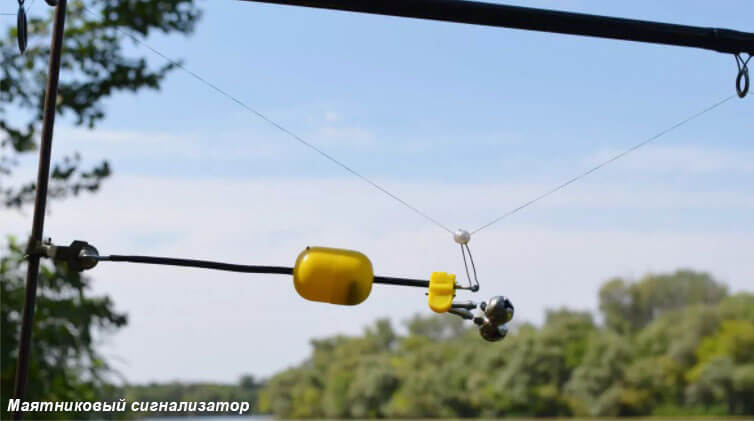
The simplest pendulum guard consists of:
- bell;
- rubber stopper or rectangular piece of foam rubber.
To make such a device you need:
- cut a piece of rubber in the shape of a parallelepiped, measuring 5x2x1 cm;
- insert a bell ring from the end of the rubber and secure it with wire or thread;
- At the opposite end of the rubber, make a cut with a blade to fix the sensor on the fishing line of the fishing rod.
After casting the tackle, the rod is placed on a stand, and the guard is attached to the fishing line below the last ring of the rod. Due to the weight of the indicator, tension is created in the fishing line; when biting, it begins to move in a horizontal plane, warning the fisherman about the need to hook.
After hooking, the alarm flies off the line, without creating problems when landing the caught fish. In order not to look for a flying guard in the grass, a piece of thin rope or fishing line is attached to the elastic band, the other end of which clings to the rod stand.
Kinder bite alarm
The simplest wire donkey alarm can be improved with the help of a plastic case from a Kinder Surprise toy. It needs to be secured to a fishing line instead of a lead weight, which will make it possible to adjust the weight of the weighting agent.
In strong winds, pendulum alarms for donkeys turn out to be ineffective due to false alarms. It is necessary to make the load heavier, and to do this, additional lead weights are placed in the body of the Kinder Surprise.
A lightweight sensor is more sensitive, but if the weather demands it, it is better to make the structure heavier to provide the necessary comfort.
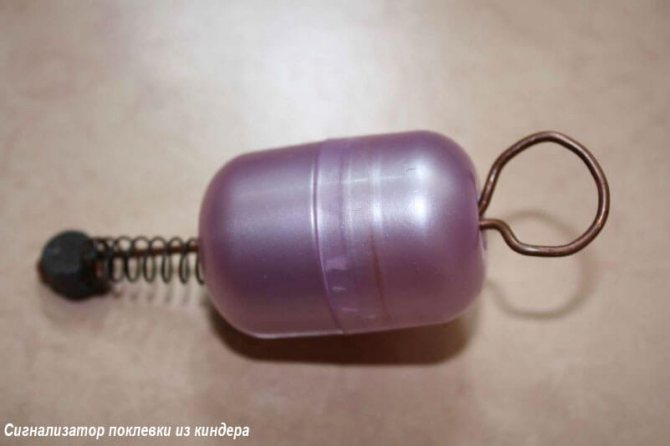
In order for the alarm for the Kinder Surprise donkey to be triggered when a fish bites towards the shore, you need to tighten the main line more strongly and put a load of at least 20 grams.
Electronic alarm
Electronic indicators for donkeys have serious advantages over other similar accessories:
- are highly sensitive;
- do not register false bites;
- fix bites towards the shore;
- allow the fisherman to take his mind off the gear;
- Easily mounted on stands or rod pods.
The high cost of electronic devices for donkeys quickly pays off with active use. Nowadays, Chinese-made electronic devices with attachment directly to the fishing rod have appeared in stores.
To install such a sensor on the tackle, you do not need a rod or stand; it is fixed on the form and does not require any additional devices. An electronic device can be made independently by those who know how to hold a soldering iron in their hands and are able to distinguish a resistor from a microcircuit.
For this you need:
- small plastic alarm clock;
- resistor;
- a piece of rigid steel wire 25-30 cm.
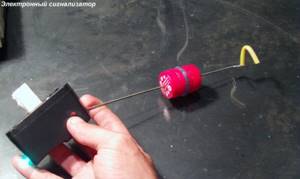
Manufacturing procedure:
- the extreme contacts of the resistor are soldered together;
- the middle contact of the resistor is attached with a wire to the alarm clock board;
- the resistor is attached to the alarm clock body with glue;
- Using an awl, holes are made in the housing opposite the resistor hole;
- A nod with a curved tip is made from wire to attach the fishing line;
- a wire nod is rigidly attached to the hole in the housing (resistor).
Such a device is attached to the rod blank with adhesive tape, the tackle is cast, and the whip is installed on the stand. The line should be taut, the nod should be fixed on it, and the guard is ready for use.
Sound alarm
Sound alarms for donkeys are necessary in cases where the angler needs to take a break from the process, or when several rods are used. Thanks to sound indication, you can fully control the process and respond in a timely manner to a possible fish bite.
The simplest example of a sound bite indicator is a bell with an elastic band, the design of which was discussed above. Fishermen also use bells or rattles, which are attached to the donkey’s whip with a clothespin and, when it vibrates, produce a loud and melodic sound.
Sound sensors are also effective at night, but it is desirable that there is also a light indication. Ball bells have a special hole for a fishing firefly, which can signal vibrations of the rod during night fishing.
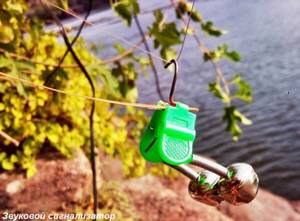
A few years ago, fishermen invented various designs of light signaling devices based on LEDs or fireflies, but now there is no such need. Chinese LED devices for registering bites are quite inexpensive, you don’t need to invent something, it’s easier to buy a ready-made accessory.
When fishing with donkeys, indicators play a big role. After all, several donks are most often used, and it is very difficult to do without additional means of indicating a fish bite.
How does an electronic alarm work?
In order for the electronic identifier to be useful when fishing, it is necessary to configure it as correctly as possible.
Operating principle of the electronic signaling device:
- Based on the use of a roller sensor.
- The line is passed through the instrument roller.
- When biting, the line begins to move to the sides, thereby moving the roller.
- Then the electrical circuit diverges and an audible signal (sound or flashing light) is issued.
Electronic alarms come in the following types:
- Sound.
- Light.
- Swinger.
- Alarm equipped with a pager.
- Sound. Sound alarms are considered the simplest, as they are equipped with a quiet sound signal, without additional functions. Newer models also have sensitivity regulation and additional settings for fishing conditions. Such a device notifies the fisherman with a sound when a fish bites.
- Light. This indicator is attached to the tip of the fishing rod and lights up green. When biting, the color starts flashing red. Runs on small batteries. More suitable for night fishing.
- Swinger. The swinger is designed to monitor the bite of fish thanks to the movements of the weight, and its signaling device can notify about the bite with light and sound signals.
- Alarm equipped with a pager. A signaling device that is equipped with a special pager has the following advantages: Thanks to the pager, you can determine which fishing rod was biting.
- You can go long distances and not be afraid that you will miss the bite. The pager can notify you of this at a distance of up to 200 meters.
- The pager can be used both wired and wireless.
Tips for choosing a pager:
- It is better to choose pagers that have a low voltage indicator so that the fisherman can see when it needs to be recharged.
- It will be more convenient to buy several alarms with a pager.
- When choosing a pager, you should pay attention to its functions. They should be adjustable, like signaling devices.
Types of models

Depending on a number of characteristics, electronic alarms can be divided into 3 groups:
- According to the method of fastening.
- According to the mechanism for detecting bites.
- By the nature of the signals given.
Depending on the method of mounting the device, there are:
- Models that are attached directly to the rod handle. At the same time, they are not large in size and not high in price. The devices are fixed using special clamps or using regular tape.
- Devices that are mounted on rod pods or on racks with which fishing rods are fixed.
Depending on the bite detection mechanism, the devices are:
- They react to vibrations of the rod, but there is no direct contact with the fishing line.
- Reacts to the tension force of the fishing line. As a rule, they use a swinger, a bite alarm. It allows you to more accurately determine the nature of the bite.
- Combined action.
Depending on the nature of the signals supplied, products are:
- Light signals are given.
- Sound signals are given.
- They provide both light and sound signals.
- Pagers.
Bite alarm, LED from aliexpress for feeder
Basic requirements for sound (electronic) alarms
Basic requirements for electronic bite alarms:
- Ease of use. When choosing a signaling device in the store, the fisherman should try to configure it himself. It is necessary that he can adjust all the settings without problems, because while fishing, making the settings with wet hands will be much more difficult.
- The presence of reliable protective covers that can protect the alarm and significantly save the fisherman’s time during installation and space in the car during transportation.
- Minimum power consumption. It is necessary that the battery of the alarm be able to use it for quite a long time, so that the fisherman does not have to recharge or change the batteries before each fishing trip.
- Reliability of the alarm. Since weather conditions for fishing can be very different (from rain to winter frost), it is best if the bite alarm is “packed” in a hermetic case that cannot allow any water or moisture to pass through.
When purchasing a sound alarm, it is desirable that it have the following characteristics:
- Additional presence of a counter.
- Well-differentiated sounds when biting “to the shore” and “from the shore” so that the fisherman does not confuse these signals.
- Availability of several outputs for the possibility of connecting a backlit indicator and an external transmitter.
- High brightness LED.
- Possibility of powering the bite indicator from widely available means.
- Good sound and the ability to completely mute the sound.
- Sufficient memory for settings.
- Confirmation signals with very quiet sounds that will not disturb or distract.
- The presence of the most comfortable handle in rotary type regulators, allowing you to rotate them even with a wet hand.
- The presence of a separate power switch, which will be located in the upper zone of the bite indicator.
Additional options that may be included in electronic bite alarms:
- Possibility to choose the appropriate LED color.
- The presence of a special button, the function of which is to temporarily disable it while installing fishing rods.
- The presence of a test mode to determine the footage of the pager.
- Connector for connecting swingers.
- Energy-saving mode (for those cases when the pager is not very far from the signaling devices).
- Low battery detection function.
- Constant glow when pulling from the shore.
- The presence of a flashing light when biting towards the shore.
- Built-in alarm in case of theft.
- Backlight for night time.
Results
The alarm should be selected depending on the type of gear used. A rig with a sliding sinker is designed primarily for fishing near the shore and is designed so that the fish does not feel resistance.
For the sliding type of equipment, electronic alarms with high sensitivity and mechanical alarms with minimal weight for tensioning the fishing line are suitable.
Blind installation of tackle is usually used for long casts. Here you should choose alarms with a stronger line tension or a stiffer spring. At a long distance, you still won’t be able to see the details of the start of the bite, and the alarm’s job is to show the angler the moment when the fish has already swallowed the bait and is dragging the line and sinker behind it. Also, when choosing a signaling device, you should pay attention to the quality of the clamps.
A bad clamp can damage the line, which can lead to its breakage.
Models of electronic signaling devices and their prices
Currently, electronic signaling companies can offer a huge selection of their products. Among this variety of devices, it is recommended to select only high-quality indicators that will last longer and be truly effective and useful for the fisherman.
Among the many popular models of alarms, the following quality companies should be noted:
- Fox kits provide the opportunity to equip your models with an individual code.
- Delkin models can be programmed with each other.
- Solar models have SIM cards.
Best Budget Options
The best budget choice would be Kosadaka model T4 signaling devices. Characteristics of Kosadaka:
- Availability of a protective cover.
- Protection of the housing from moisture penetration.
- Tone that can be adjusted.
- Volume, which can also be adjusted
This set of alarms, which includes 3 W99S fishing rods, will cost 200-230 USD. e. The presence of all basic functions and reasonable prices in such alarms makes them in demand among novice fishermen.
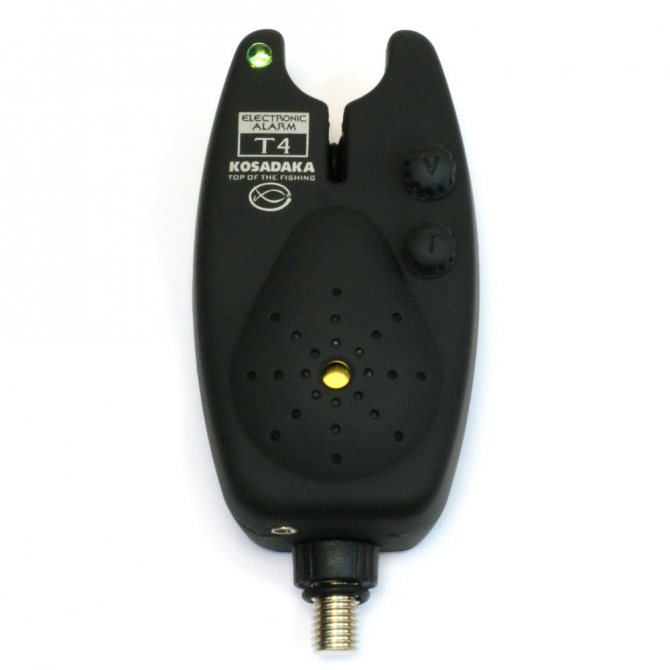
The second budget option is the Delkim Tx-i Plus model. Characteristics:
- The presence of a built-in pager with several channels, which allows you to inform the fisherman about fish biting at fairly large distances.
- This model has all the basic functions of signaling devices, which does not distinguish it from expensive signaling devices.
The price of the Delkim Tx-i Plus signaling device is 220-230 USD. e.
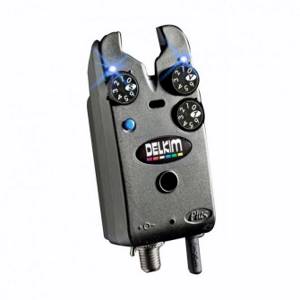
Best in average price
Barracuda T5 alarm is suitable for most fishermen because its price and features are at a good level. The price for such a device starts from 450-500 USD.
Characteristics of the Barracuda T5 model:
- Customizable tone, sound, volume, light.
- Availability of alarm system.
- Possible sensitivity setting.
- Water resistance of the case.
- Charged by a nine-volt “crown”.

The second popular model for an average price is Carp ProFlash. Model characteristics:
- Has up to 4 LED colors.
- Availability of alarm system.
- Adjustable volume and tone.
- Has a memory of the last bite (20 seconds).
- Has a connector for connecting an additional swinger.
- Meal 9 according to the “Crown” type.
The price of Carp ProFlash starts from 640 USD.
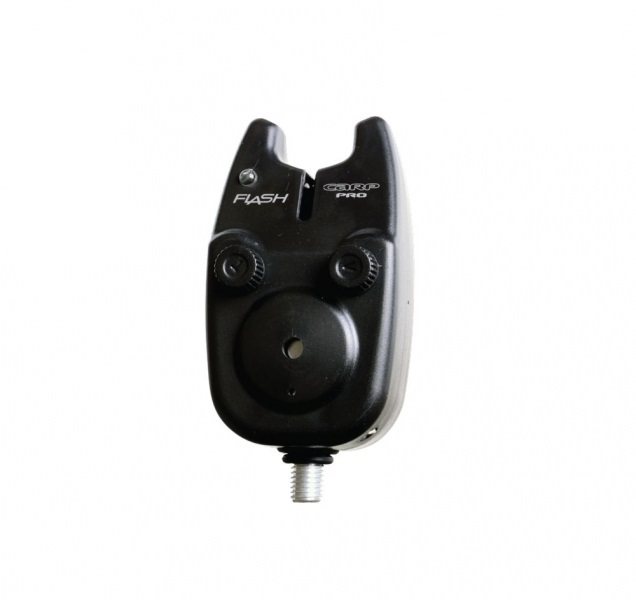
The best expensive models
Expensive models are usually the highest quality and most reliable. They are equipped with the latest innovations and features.
Winner alarm systems are considered to be among the highest quality. Their price ranges from 1010 to 1200 USD.
Characteristics of Winner signaling devices:
- Availability of two high quality batteries.
- Waterproof housing.
- Availability of a special connector for swinger.
- Suitable for use in all weather conditions.
- Touch buttons for use.
- Adjustable sensitivity.
- Adjustable volume and sound tone.
- 24-hour sound and light indication.
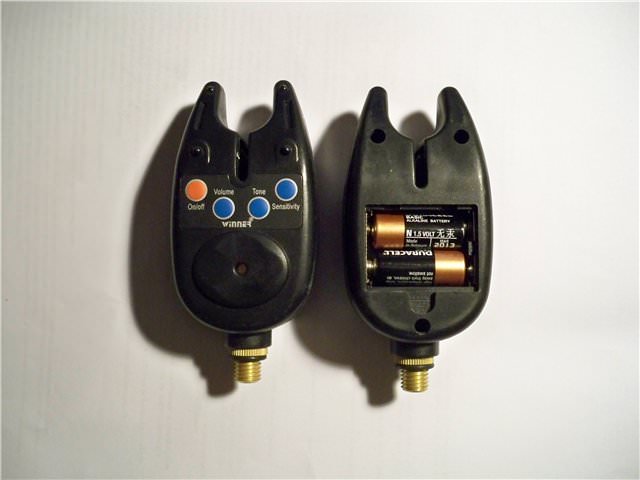
Another effective, expensive model is the RX NX-R series alarm kit from Fox International. 4 alarms with a pager can successfully monitor all fishing rods within a radius of 200 m from the feeders. The price for such a set with 4 alarms is 1400-1470 USD. e.
Fox International RX NX-R Features:
- Possibility to enter a code for each alarm device.
- The presence of four bright LEDs.
- Illumination for night fishing.
- The presence of a LED flashing function if the fish swims away from the desired place.
- Swinger connection compartment.
- Test mode.
- Adjust sensitivity, sound volume and tone.
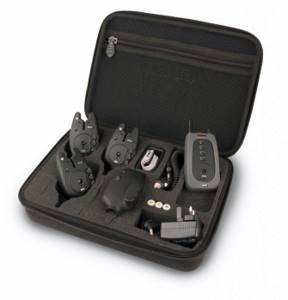
Chinese feeder alarms
Fishing supplies are not in short supply. You can always make alarms yourself or buy them on Aliexpress or other online stores. Mechanical and electronic versions made in China are of decent quality.
Many models come with pagers that you can wear on your arm or belt. In the best bite alarm from China - TONOQUU - the mount is made in the form of a clothespin with a silicone pad. A multifunctional gadget with sound and light signals and a volume control, it responds perfectly to the slightest touch of a fish on the fishing line. In the top 5 best fishing products, this alarm takes second place.
Installation of bite alarms
Installation of bite alarms is done in this way:
- The feeder is adjusted to a stand (the most convenient stand is considered Rod-Pod).
- The bite identifier is attached to the stand using a special threaded hole.
- A fishing line is threaded through the electronic indicator roller.
- The friction brake is released (only if the reel is not equipped with a baitrunner system).
- Special adjustments are made to the volume, sound tone, light and sensitivity level on the bite indicator.
- The length of the brace is adjusted, which depends on the fishing area, as well as the power of the wind gusts (usually its length ranges from five millimeters to 4-5 centimeters).
"Megatex"
A detailed article about this alarm can be read here. The main difference of this alarm is that there is no need to use fishing line. The device is made in a round body and is attached to the fishing rod using improvised means (for example, adhesive tape or tape). The indicator contains a sensor and a microchip that processes signals.
As soon as the tip of the feeder moves, the indicator will give a signal to the fisherman. The device is equipped with a light and sound signal.
To prevent false alarms (for example, from wind), the microchip contains a program that can distinguish a bite from another effect on the tip.
The indicator has five sensitivity adjustment modes.
It has an automatic shut-off function when hooking a fish. The device has a built-in energy saving system. After three hours of inactivity, the alarm turns off.
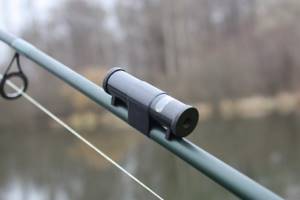
The manufacturer assures that the device can operate for more than five years, or five thousand hours, without requiring battery replacement. The alarm housing is sealed, the operating temperature range is from minus forty to plus sixty-five degrees. The weight of the device is twelve grams.
Use visual and audible alarms together or one of them is sufficient
Usually, it is customary to use both alarms together, since together they give a much better and more accurate result. Using both types of identifiers simultaneously is very convenient for the fisherman, since when catching carp they often use several fishing rods on which these auxiliary devices can be installed.
In addition, the fisherman may not be near the gear all the time, since an electric alarm using a pager will notify him of a bite even tens of meters away.
Blitz tips
- You should always have at least one additional power supply for alarms and pagers in stock.
- To protect yourself from oddities while fishing, after catching fish you need to immediately turn off the pager and alarm so that they do not run out of charge.
- It is necessary to pack the pager and alarms very carefully so that they cannot accidentally turn on during transportation.
- It is advisable to use special protective packaging for signaling devices that will protect these devices from damage and various breakdowns.
- When re-casting the gear and adjusting the line tension, you need to turn off the sound of the alarm so as not to disturb the fishermen who are nearby with this sound.

